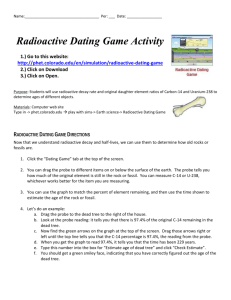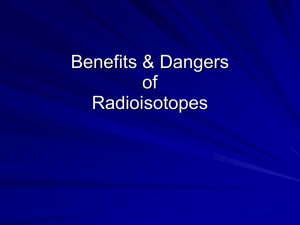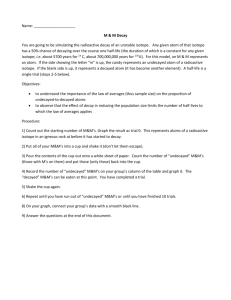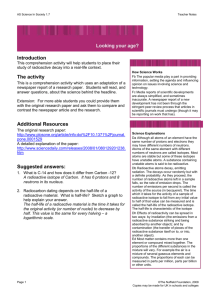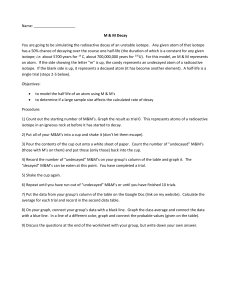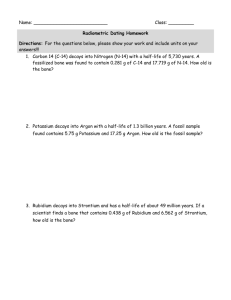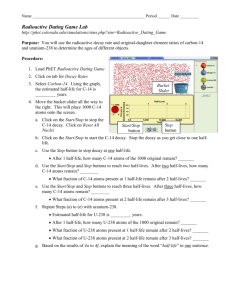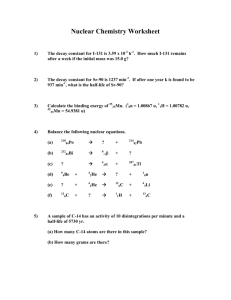Radioactive dating game: directions + questions
advertisement
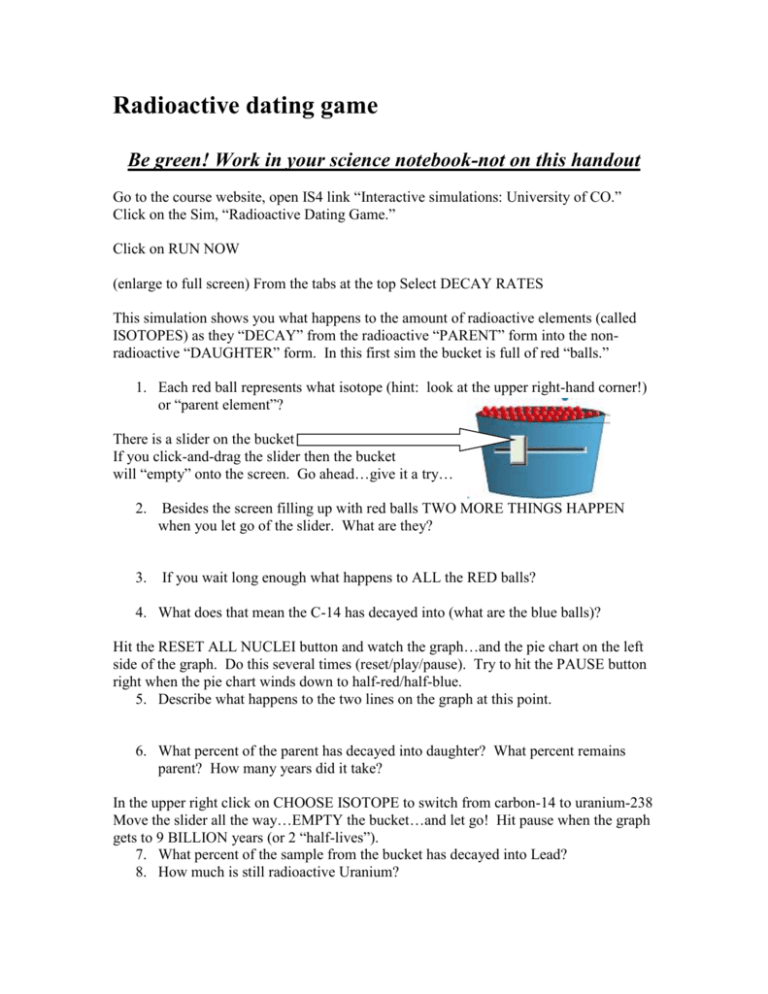
Radioactive dating game Be green! Work in your science notebook-not on this handout Go to the course website, open IS4 link “Interactive simulations: University of CO.” Click on the Sim, “Radioactive Dating Game.” Click on RUN NOW (enlarge to full screen) From the tabs at the top Select DECAY RATES This simulation shows you what happens to the amount of radioactive elements (called ISOTOPES) as they “DECAY” from the radioactive “PARENT” form into the nonradioactive “DAUGHTER” form. In this first sim the bucket is full of red “balls.” 1. Each red ball represents what isotope (hint: look at the upper right-hand corner!) or “parent element”? There is a slider on the bucket If you click-and-drag the slider then the bucket will “empty” onto the screen. Go ahead…give it a try… 2. Besides the screen filling up with red balls TWO MORE THINGS HAPPEN when you let go of the slider. What are they? 3. If you wait long enough what happens to ALL the RED balls? 4. What does that mean the C-14 has decayed into (what are the blue balls)? Hit the RESET ALL NUCLEI button and watch the graph…and the pie chart on the left side of the graph. Do this several times (reset/play/pause). Try to hit the PAUSE button right when the pie chart winds down to half-red/half-blue. 5. Describe what happens to the two lines on the graph at this point. 6. What percent of the parent has decayed into daughter? What percent remains parent? How many years did it take? In the upper right click on CHOOSE ISOTOPE to switch from carbon-14 to uranium-238 Move the slider all the way…EMPTY the bucket…and let go! Hit pause when the graph gets to 9 BILLION years (or 2 “half-lives”). 7. What percent of the sample from the bucket has decayed into Lead? 8. How much is still radioactive Uranium? 9. Based on what you figured out so far, IN YOUR OWN WORDS, what is a “halflife”? Here…I’ll get you started; “It’s the number of years… Click on the Tab MEASUREMENT. Then, under CHOOSE AN OBJECT, pick Tree. Hit the button PLANT TREE Hit PAUSE before it loses all its leaves…like around “1200 years”!!! (you may need to hit reset). 10. Describe the line on the graph. 11. What percent of C-14 does the probe say is present in the living tree? (living trees keep taking in “fresh” C-14) Hit play…let the tree die. Hit pause as close as you can to 3000 years. 12. Describe the line on the graph. 13. What percent of C-14 does the probe say is still in the dead tree? (dead trees can no longer absorb “fresh C-14) Hit play…wait until the probe says (about) 50% of the C-14 has decayed. 14. What is the half-life (this time…it is rarely EXACTLY the same twice) of C-14? While not EXACT, the half-life is pretty consistent…scientists often state the radiocarbon dating of an object as “10,000 years plus or minus 50 years.” 15. Why would they say that? 16. Would you consider the data reliable? Why or why not? Now “Choose” the rock. Click on ERUPT THE VOLCANO…wait for a piece of lava to fly over near your probe. Why is the probe measuring O%!? aaaaaaah…you have it set to C-14…remember carbon’s half life!? This rock is WAAAAAY too old (look how fast the years are piling up!). You need an isotope with a MUCH greater half-life…like… hmmmm…say….U-238!? Change your probe settings and reset the volcano. 17. How many years does it take for about 75% of the parent element to decay? 18. What is U-238’s half-life? 19. Why can’t you use U-238 to “date” the dead tree? (go ahead…try it…I dare you) 20. Which isotope would you use to date the fossil of a T. rex dinosaur…carbon or uranium? Why? (hint: dinosaurs died 65MY ago …or more!) You wanna date ME!? Sorry…I just don’t “like you like that.” Now you’re ready for the Dating Game…click on it. Click-and-drag your probe over to the (femur) bone in the top layer. Your probe should indicate that 83.9% of the C-14 has decayed since the animal died. Grab the green arrow and drag left/right. Watch what happens. Now, drag it LEFT until the Carbon amount gets on/close to 83.9%. See the t = years? Record that number in the box, GUESS AGE OF BONE and hit the button, CHECK GUESS. If you’ve done good, you’ll get the green smiley face!! Now, move the probe to various objects (both above and below ground) and use the tool at the top to figure out their ages! This is possible ONLY because radioactive decay works like an “atomic clock”…it is reliable and predictable. Be careful to pay attention to the isotope you use! (MY = million yrs!) 21. Write the ages (& isotope used) below (I did one for you as an example); animal skull= rock 3= 470,000,000 (U-238) trilobite= wooden cup= dead tree= rock 5= fish bones= house= rock 4= (either) living tree= fish fossil 1= rock 1= human skull (top layer)= human skull (second layer)= (carbon-14 won’t work!?...try a “custom” isotope that has a half-life of 100 ky) rock 2= Age Range dinosaur skull= Top Layer = 22. Regarding the “Theory of Superposition” (that the youngest layers lie on top of older layers), does the data in Question #21 support or contradict the theory? = = Back it up w/DATA! Estimate the age range of each of the 5 layers based on the age of the objects…. 23. EVOLUTION requires time…EPIC amounts of time. How is RADIOACTIVE DECAY (and the data it provides) “EVIDENCE*” that supports the Theory of Evolution? Bottom Layer = = = =
